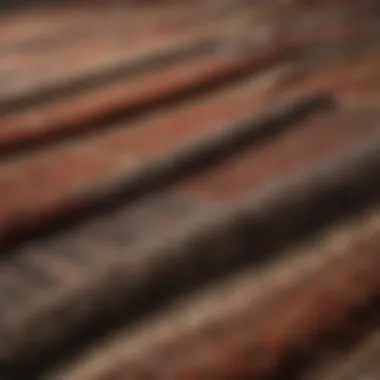A Comprehensive Guide to Carpet Cleaning Techniques


Intro
Carpets often serve as the foundation of a room's aesthetic. They add warmth and comfort but also accumulate dust, stains, and odors over time. For homeowners and design enthusiasts, understanding how to properly clean and maintain carpets is crucial. Regular cleaning not only enhances the visual appeal but also contributes to a healthy living environment.
This article delves into effective methods for cleaning carpets. We will discuss various techniques dependent on carpet types. Furthermore, we will highlight essential tools and materials, provide tips for removing specific stains, and underline the importance of routine maintenance.
Now, let’s explore the different cleaning methods and tools that will keep your carpets looking fresh and vibrant.
Understanding Your Carpet
Cleaning your carpet effectively begins with a fundamental understanding of the material itself. Each carpet type possesses unique attributes, which imply distinct care requirements. This section illuminates the significance of knowing your carpet. Understanding its composition and characteristics helps in selecting the appropriate cleaning techniques and products. Emphasizing this knowledge can lead to a longer lifespan for your carpet and enhanced appearance. When homeowners grasp these essentials, they become equipped to maintain an optimal living environment, avoiding premature wear or damage.
Types of Carpets and Their Care Requirements
Carpets generally fall into two primary categories: natural fibers and synthetic fibers. Natural fibers, such as wool, silk, and cotton, offer luxurious textures but demand specific care due to their susceptibility to stains and moisture. Wool carpets, for instance, can shrink or become misshapen if wet cleaning is not handled correctly. In contrast, synthetic fibers, like nylon, polyester, and olefin, are more durable and resistant to staining, making them easier to maintain.
- Wool Carpets: Require gentle cleaning methods, typically involving low moisture and specialized wool cleaners.
- Nylon Carpets: Can handle a range of cleaning solutions but benefit from regular vacuuming to prevent soil accumulation.
- Polyester Carpets: Generally stain-resistant and easy to clean but may require higher temperatures during cleaning.
- Olefin Carpets: Best suited for outdoor areas due to their water and stain resistance but still need periodic deep cleaning.
Knowing these differences allows carpet owners to select suitable products and methods, ultimately preserving their carpets' beauty and longevity.
Common Carpet Cleaning Myths
Many prevalent myths surround carpet cleaning. The understanding of these misconceptions can guide homeowners in making informed decisions regarding carpet maintenance. One common myth suggests that vacuuming less often leads to a cleaner carpet because it allows dust and dirt to settle.
Fact: Regular vacuuming removes dirt before it becomes embedded in the fibers, which helps maintain both cleanliness and carpet life.
Another misleading belief states that light-colored carpets require more frequent cleaning than dark ones. In reality, stains and dirt can be just as visible on dark carpets, and they often trap dirt out of sight.
Lastly, some assume that all cleaning products are safe for every carpet type. However, using the wrong product can cause discoloration or damage. Understanding the specific requirements of your carpet, combined with awareness of these myths, enables better care strategies.
Preparation for Carpet Cleaning
Preparation for carpet cleaning is a vital step that can significantly enhance the effectiveness of your cleaning efforts. Understanding the specific requirements of your carpets, the condition they are in, and planning your approach contributes to efficient cleaning and helps maintain the longevity of your carpets.
Gathering Necessary Tools and Materials
To clean carpets effectively, having the right tools and materials is essential. Here are some of the must-have items:
- Vacuum Cleaner: A powerful vacuum cleaner is necessary to remove loose dirt and debris before deeper cleaning.
- Carpet Shampoo: Depending on your carpet type, choose a suitable carpet shampoo that matches the fibers.
- Stain Remover: Specific products are designed to tackle different stains, including pet urine, food spills, and mud.
- Brushes: Soft-bristled brushes are ideal for gently scrubbing carpets without causing damage.
- Rags and Towels: They are useful for blotting up any spills or excess cleaning solution.
- Buckets and Bins: Have a bucket ready for mixing solutions and a bin for collecting waste.
Having these items gathered before starting will save time and help organize the cleaning process effectively.
Assessing Carpet Condition
Assessing the condition of your carpets before cleaning is a critical step. Look for various indicators:
- Stains: Identify the types and severity of stains present on the carpet.
- Wear and Tear: Note any signs of fraying, fading, or damage that might require special attention.
- Allergens: Check for dust or allergens trapped in the fibers, prompting in-depth cleaning.
This assessment will guide you in choosing the proper cleaning methods and products, ensuring a more thorough clean.
Creating a Cleaning Schedule
Establishing a cleaning schedule is important for maintaining your carpets over time. Consider these factors when creating your schedule:


- Traffic Levels: High-traffic areas will need more frequent cleanings than less-used spaces.
- Carpet Type: Certain materials require specific cleaning methods and frequency to retain their appearance.
- Seasonal Changes: Dust and allergens can vary with the seasons, affecting how often you clean.
"Regular maintenance prevents buildup, prolongs carpet life, and enhances your living space's aesthetics."
Determine a reasonable timeline for cleaning, whether monthly vacuuming or annual deep cleaning strategies. Consistency is key to preserving the integrity of your carpets. By preparing appropriately, homeowners can ensure a clean and inviting home environment.
Vacuuming Techniques
Vacuuming is an essential part of carpet maintenance. It serves as the first line of defense against dirt and debris that can accumulate. Proper vacuuming not only prolongs the life of the carpet but also contributes significantly to the overall hygiene of the home. Regular vacuuming can reduce allergens, improve air quality, and enhance the appearance of the flooring. Understanding the right techniques will help achieve optimal results in keeping carpets clean.
Proper Vacuuming Methods
Using the correct vacuuming method is crucial for effective cleaning. Here are some key points to consider:
- Select the Right Vacuum: Not all vacuums are suitable for every carpet type. For plush carpets, a beater brush vacuum can be useful. However, a canister vacuum might be better for delicate fibers.
- Adjust the Height: Before starting, ensure the vacuum height is adjusted according to the carpet pile. A vacuum that is too low can damage the fibers, while one that is too high may not pick up dirt effectively.
- Vacuum in Multiple Directions: To lift dirt more effectively, it is wise to vacuum in different directions. This technique allows the vacuum to reach dirt that may be stuck in the fibers.
- Slow and Steady: Rushing through vacuuming can result in missed spots. Pacing yourself will ensure that the vacuum has time to suck up dirt effectively.
Regular vacuuming techniques can significantly improve carpet longevity and appearance.
Frequency of Vacuuming
The frequency of vacuuming is influenced by several factors, including household foot traffic and the presence of pets. A good rule to follow is:
- High Traffic Areas: Areas such as living rooms or hallways may need vacuuming every day.
- Moderate Traffic Areas: For rooms with less foot traffic, vacuuming once a week is typically sufficient.
- Pet Owners: If there are pets, more frequent vacuuming—possibly three to four times a week—is advisable to combat pet hair and dander.
- Seasonal Considerations: During periods of increased pollen, such as spring, it might be necessary to vacuum more often to reduce allergens.
Incorporating effective vacuuming techniques into your cleaning regimen can substantially contribute to maintaining your carpets. This not only enhances their aesthetic appeal but also promotes a healthier living environment.
Spot Cleaning Stains
Spot cleaning stains is a critical aspect of carpet maintenance. Stains can be unsightly and, if not addressed promptly, can lead to permanent damage. This section emphasizes how immediate action on stains not only preserves the visual appeal of your carpet but also maintains a hygienic environment in your home. Timely spot cleaning is essential for extending the lifespan of your carpet, especially in high-traffic areas.
Identifying Stains and Their Treatment
Knowing how to identify different types of stains is vital for effective treatment. This knowledge can help you choose the right cleaning method. Common household stains include food spills, pet accidents, ink, and mud. Each stain type has specific characteristics and may respond best to certain cleaning approaches. For example, oil-based stains might require a solvent while water-based stains can often be tackled with basic carpet cleaner solutions.
Key Identifying Tips:
- Color: Bright stains like red wine are usually more challenging to remove than brown stains from food.
- Odor: If a stain has a strong odor, it might signal deeper issues, such as bacteria.
- Texture: A stain that feels sticky may require a different treatment than a dry, crumbly stain.
Once a stain is identified, treatment can begin. Blotting with a clean cloth is often the first step. Avoid rubbing as it can spread the stain further.
Homemade Cleaning Solutions
Homemade cleaning solutions can be a practical and eco-friendly approach to tackle stains. Many household items can effectively work on stains without the need for harsh chemicals.
Here are a few simple yet effective homemade solutions:
- Vinegar and Water: Mix equal parts of white vinegar and water. This solution is great for neutralizing odors and can help lift stains like coffee or tea.
- Baking Soda Paste: Combine baking soda with a small amount of water until it forms a paste. This works well on grease stains. Apply the paste, let it sit, then gently scrub.
- Dish Soap Mix: A few drops of dish soap mixed with warm water can be used on various stains, especially those from food.
Application Tips:
- Apply your chosen solution directly to the stain or use a cloth to dab the area.
- Always test a small inconspicuous area first to ensure the solution does not discolor your carpet.
Commercial Stain Removers
While homemade solutions are useful, sometimes a more robust approach is required. Commercial stain removers can provide targeted treatment for specific stain types. Products like Resolve or OxiClean are designed to penetrate deeply into the fibers, which can be particularly useful for tough stains like red wine or ink.


Important Considerations When Using Commercial Products:
- Read Labels: Always follow the manufacturer's instructions to avoid damage.
- Test First: Conduct a patch test in an inconspicuous area to check for adverse reactions.
- Consider Ingredients: Choose products with safe ingredients, especially in homes with pets or children.
Deep Cleaning Methods
Deep cleaning methods are crucial in maintaining the longevity and appearance of carpets. Unlike regular vacuuming and spot cleaning, deep cleaning penetrates deeper into the carpet fibers. This method helps to eliminate built-up dirt, allergens, and stains that regular cleaning might miss. Regular deep cleaning can also help to restore the health and vibrancy of carpets, enhancing the overall aesthetic of a room.
There are several deep cleaning techniques, each with its own merits and considerations. Homeowners should be informed of these nuances to choose the right method for their specific needs.
Steam Cleaning Advantages and Techniques
Steam cleaning, also known as hot water extraction, leverages heat and moisture to agitate dirt and extract it from carpet fibers. The primary advantage of steam cleaning is its effectiveness. The high-temperature steam not only dislodges dirt but also sanitizes the surface, killing dust mites and bacteria. This makes it an excellent choice for households with pets or allergies.
To steam clean effectively:
- Pre-treat Stains: Use a suitable solution to target any specific stains prior to steaming.
- Use a Quality Machine: Invest in a reliable steam cleaner or hire a professional service.
- Follow Directions: Each cleaner may have different instructions; it’s crucial to adhere to these for the best results.
"Steam cleaning not only cleans, but it also disinfects, offering a deeper cleanse than traditional methods."
Dry Cleaning Carpets
Dry cleaning carpets involves a different approach, primarily utilizing solvents instead of water. This method is suitable for carpets that may be sensitive to moisture. Dry cleaning can effectively remove stains while minimizing drying time. Moreover, it reduces the risk of mold and mildew that can arise from excess moisture.
For dry cleaning:
- Choose Dry Cleaning Powder: These are sprinkled on the carpet and work its way into fibers. They trap dirt and odors.
- Use a Brush or Machine: After applying the powder, use a brush or a dry-cleaning machine to agitate the fibers, enhancing the cleaning process.
- Vacuum Thoroughly: Once the solution has dried, vacuum the carpet to remove residue.
Professional Cleaning Services
Hiring professional cleaning services can be an efficient option for maintaining carpets. Experts use advanced techniques and equipment that provide a level of cleanliness difficult to achieve through DIY methods. Professional cleaning may also offer specialized treatments, such as stain protection or carpet repair.
When considering professional services, keep in mind:
- Research Reputable Companies: Look for reviews and ratings to ensure quality service.
- Ask About Methods Used: Ensure they use environmentally friendly products if that is a priority.
- Schedule Regular Cleanings: Regular professional cleanings can extend the life of your carpets significantly.
Post-Cleaning Care
Post-cleaning care is a critical phase in the carpet cleaning process. Once you've gone through the effort of cleaning your carpets, the next steps will help preserve that work and extend the lifespan of your carpets. This phase ensures that the carpets dry properly, remains fresh, and retains its visual and functional quality.
Drying Techniques and Tips
Efficient drying after cleaning is vital to avoid problems such as mildew development or persistent odors. Here are some techniques to enhance the drying process:
- Ventilation: Open windows and doors to facilitate air circulation. If possible, use fans to boost airflow across the carpet.
- Humidity Control: Keep the indoor humidity low. A dehumidifier may help to absorb excess moisture in the air, aiding faster drying.
- Absorbent Towels: Blot the carpet with clean, absorbent towels immediately after cleaning to soak up some of the water.
- Temperature Regulation: Keep the room warm. Warmer air can enhance moisture evaporation, thus reducing drying time.
In addition to these tips, avoiding walking on the carpet until it's completely dry minimizes surface impressions and potential damage. Timely care here makes a significant difference in preserving the integrity of the fibers and overall aesthetics.
Maintaining Carpet Freshness
To keep carpets smelling fresh and looking clean, regular maintenance is essential. Here are some actionable steps to maintain the freshness of your carpets:
- Regular Vacuuming: Frequent vacuuming eliminates dirt and debris. Aim for at least once a week, or more if your household has pets or children.
- Air Freshening: Using carpet-safe air fresheners can help eliminate odors without damaging the fibers. Alternatively, sprinkle baking soda on carpets, let it sit for a few hours, and vacuum to absorb pesky odors.
- Professional Cleaning Schedule: Schedule professional cleaning at least once a year. This helps to remove deep-seated dirt and allergens, contributing to both a cleaner look and healthier air quality.
- Spot Clean Regularly: Address small spills and stains as they happen. Use solutions designed for your carpet type to avoid long-lasting marks.


Regular maintenance not only keeps your carpets looking great but also enhances their lifespan. Collaborate these efforts with periodic professional cleaning for the best results.
In summary, by recognizing the importance of post-cleaning care, homeowners can effectively prolong the freshness and visual appeal of their carpets. A thoughtful approach to drying and ongoing maintenance ensures carpets continue to enhance living spaces for years to come.
Preventative Maintenance
Preventative maintenance is a crucial aspect of carpet care that can save both time and money in the long run. By engaging in consistent upkeep and management, homeowners can significantly prolong the life of their carpets. This section delves into essential strategies that effectively mitigate the buildup of dirt and stains, thereby maintaining the cleanliness and condition of the carpet.
One of the key benefits of preventative maintenance is its role in reducing the frequency of deep cleaning required. When carpets are regularly maintained, they resist dirt accumulation and staining more effectively. This not only keeps the carpet looking fresh but also minimizes the amount of embedded dirt that becomes harder to remove over time. Consider these practices:
- Regular vacuuming to remove surface dust and dirt.
- Promptly addressing spills to prevent staining.
- Using high-quality mats and runners to protect high-traffic areas.
Moreover, understanding the material of your carpet helps in determining the most effective preventative measures to implement. Different carpets necessitate unique cleaning approaches, making it important to adjust your maintenance strategy accordingly.
"Regular upkeep can prevent unsightly wear and prolong the carpet's aesthetic appeal."
Maintaining carpets also contributes to the overall hygiene of the living space. By preventing the buildup of allergens and dust mites, carpet maintenance can create a healthier environment. This is particularly important for households with allergies or respiratory issues.
In essence, the practice of preventative maintenance often includes a combination of effective cleaning techniques, careful monitoring of the carpet's condition, and engaging professional services when necessary. By investing time in regular carpet care, one not only preserves the look but also the longevity and function of their carpets.
Using Mats and Runners
Using mats and runners in key areas of the home is an effective strategy for preventative maintenance. Placing mats at entryways or high-traffic zones helps trap dirt and moisture before it reaches the carpet. It is crucial to select mats that are durable and easy to clean, ensuring that they effectively serve their purpose without becoming a source of dirt themselves.
Another benefit of strategically placed mats is their ability to absorb impacts from foot traffic, reducing wear and tear on the carpet beneath. Regular cleaning of these mats is necessary to maintain their effectiveness, so they should be machine washable or vacuumable. Furthermore, rotate and replace these mats regularly to prevent discoloration or deterioration, enabling extended protection for the underlying carpet.
Regular Professional Cleaning
In addition to self-care strategies, regular professional cleaning is essential for maintaining carpets. Scheduling a professional cleaning service every six to twelve months can not only ensure deeper dirt removal but also rejuvenate the carpet fibers. Professionals often have access to advanced equipment and specialized cleaning solutions that can achieve results far beyond typical household methods.
This service is particularly beneficial for households with pets or small children, where spills and accidents are more frequent. Professional cleaners can treat issues that may not be addressed through routine maintenance, such as stubborn stains and odors. Nonetheless, choosing a reputable professional service is important to avoid any potential damage to the carpet during the cleaning process.
Investing in regular professional cleaning also helps in protecting the warranty of many carpet types, as manufacturers often require such maintenance. This dual approach of self-care and professional expertise maximizes care effectiveness, ensuring that carpets remain in optimal condition for years.
Finale and Final Thoughts
The conclusion of this guide synthesizes the pivotal elements of carpet cleaning. It emphasizes the need for a comprehensive understanding of the various methods and techniques that can keep carpets clean and well-maintained. As carpets play a vital role in the aesthetic appeal and comfort of a home, proper maintenance is essential not only for visual interest but also for hygiene.
By following the discussed strategies, including regular vacuuming, effective stain treatment, and deep cleaning methods, homeowners can significantly extend the lifespan of their carpets. Each cleaning method — whether it’s steam cleaning, dry cleaning, or professional services — carries distinct advantages that cater to different needs.
It is also key to consider the specific materials and styles of the carpets in your home. This knowledge influences your choice of cleaning methods, ensuring the right approach for various carpet types. Failure to adhere to suitable cleaning practices can lead to premature wear and unsightly stains.
"Carpet care is an investment in home comfort and cleanliness."
In summary, engaging with this article empowers readers with the necessary tools to maintain carpets effectively, ensuring they remain a valued asset in any living space.
Summarizing Key Points
In re-evaluating the essential takeaways, several important points emerge:
- Understanding Types of Carpets: Recognizing the different carpet types guides proper care techniques.
- Preparation: Having the right tools and evaluating carpet condition are crucial initial steps.
- Vacuuming: Regular vacuum routines prevent the accumulation of dirt and prolong carpet life.
- Spot Cleaning: Timely identification and treatment of stains significantly reduce their permanence.
- Deep Cleaning: Implementing methods like steam cleaning or hiring professionals keeps carpets hygienic.
- Post-Cleaning Care: Following appropriate drying techniques and regular maintenance helps maintain freshness.
Each step contributes to effective carpet care that enhances the longevity and aesthetic value of the carpeting.
Long-term Benefits of Carpet Care
Prioritizing carpet care goes beyond immediate cleanliness; it offers several long-term benefits:
- Prolonged Lifespan: Regular cleaning prevents wear and tear, extending the life of your carpets.
- Improved Air Quality: Keeping carpets clean reduces allergens, contributing to a healthier home environment.
- Aesthetic Appeal: Well-maintained carpets enhance the overall appearance of living spaces, reflecting character.
- Cost-Effectiveness: Investing in maintenance can save substantial costs associated with premature replacement.
Moreover, a habitual cleaning schedule ingrains a sense of responsibility that fosters better overall care for the entire home. Thus, the practice of maintaining carpets aligns with broader home management strategies that lead to satisfaction in one’s living space.







